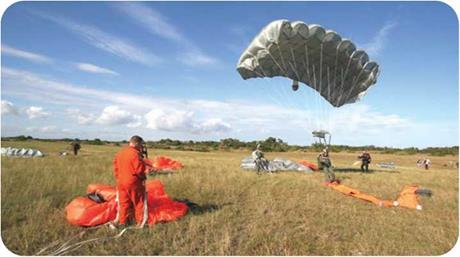Paratroops and Ejector Seats

 |
The military began to realize the tactical importance of parachutes for landing both troops and supplies from aircraft. Airborne units were formed and used in World War II (1939-1945). The Germans used paratroops to attack Crete in 1941. In 1944, thousands of Allied airborne troops were dropped from the skies above Europe during the D-Day and Arnhem assaults. Transport planes also parachuted supplies to soldiers and dropped food and medicines to civilians.
О The 150-foot (46-meter) solid rocket boosters used to launch the Space Shuttle are retrieved for reuse after they travel back to Earth with the help of parachutes.
During World War II, Allied fighter pilots and bomber crews used parachutes. Hundreds of combat fliers parachuted from planes, often after their planes had been hit by enemy fire. After the U. S. Doolittle Raid on Tokyo in 1942, all but one of the B-25 crews taking part had to use parachutes when their planes ran out of fuel over China.
In the 1940s, new parachute techniques were invented for jet pilots. The ejection seat, first tried in 1946, was available by 1951 with a pressure – operated parachute that would open at a preset, safe altitude. All a pilot had to do was jettison the cockpit cover and pull down a face blind; he and his seat were ejected from the airplane, and the parachute opened. Ejection seats are now standard in most military airplanes.










